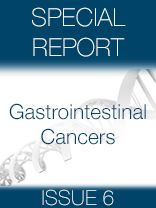Clinical Review: Regorafenib in Refractory mCRC
"While adverse events across both populations were broadly similar, some did occur more frequently in patients with longer exposure, an observation that is possibly related to the longer duration in this subgroup," said Axel Grothey, MD.
Clinical Review: Regorafenib in Refractory mCRC

Axel Grothey, MD
The FDA approved regorafenib (Stivarga) for patients with metastatic colorectal cancer (mCRC) following prior treatment with fluoropyrimidine-, oxaliplatin-, and irinotecan-based chemotherapy, with an anti­VEGF therapy, and, if KRAS wild type, with an anti–EGFR therapy in September 2012.
The approval for regorafenib was based on the international phase III CORRECT study,1which compared the multikinase inhibitor plus best supportive care (BSC) with BSC plus placebo. In the trial, 760 patients with previously treated mCRC were randomized in a 2:1 ratio to regorafenib (n = 505) or placebo (n = 255). Regorafenib was administered orally at 160 mg per day for 21 days of each 28-day cycle.
In the findings that were instrumental in the approval, regorafenib demonstrated a statistically significant improvement in overall survival (OS) and progression-free survival (PFS) compared with placebo. Median OS was 6.4 months in the regorafenib arm compared with 5.0 months with placebo (HR, 0.77; 95% CI, 0.64-0.94;P= .0102). Median PFS was 2.0 versus 1.7 months, with regorafenib and placebo, respectively (HR, 0.49; 95% CI, 0.42-0.58;P<.0001).
In a safety analysis from 500 patients in the regorafenib arm and 253 from the placebo group, the most frequently observed all-grade adverse events (AEs) were asthenia/fatigue, decreased appetite, hand-foot skin reaction (HFSR), diarrhea, mucositis, weight loss, infection, hypertension and dysphonia.
The most commonly reported serious AEs with regorafenib were hepatotoxicity, hemorrhage, and gastrointestinal perforation. As a result of these events, regorafenib was approved with a boxed warning for the risk of hepatotoxicity.
Time Course of Regorafenib-Related AEs
Following the approval of regorafenib, a number of clinical trials and subgroup analyses were conducted in order to fully characterize the safety and efficacy of the agent. In an early subanalysis of the CORRECT trial,2it was revealed that AEs with regorafenib were highest during the first treatment cycle and then tapered off in subsequent cycles.
During cycle 1 of regorafenib, the incidence of fatigue was about 45% and the incidence of HFSR exceeded 30%. The incidence of fatigue dropped to 23% and HFSR was reduced to 26% during cycle 2. These events remained relatively stable until cycle 6, after which point the rates of fatigue and HFSR continued to decrease further.
The incidences of hypertension and rash/desquamation were highest in cycle 1, at 20% to 25%, respectively. These events tapered to low or no incidence over cycles 2 to 8. The incidence of diarrhea remained relatively constant from cycles 1 to 6, but was lower in cycles 7 and 8.
“The time course suggested an initial flare-up of key side effects, in particular fatigue and HFSR, and then over time these side effects decreased in incidence but also in severity,” said lead study author Axel Grothey, MD, from the Mayo Clinic. “There were a higher number of early grade 3 adverse events but over time, even if you keep the same dose, these side effects fade away a little bit.”
There was no evidence of cumulative toxicity with regorafenib. The proportion of regorafenib received was highest in cycle 1 and decreased over cycles 2 and 3 as the dosage was adjusted to manage AEs. The dose density remained relatively stable over cycles 3 through 8.
“The dose that people could be maintained on over a longer term was about three quarters of the doseinstead of 160 mg, it was 120 mg,” Grothey said. “The way adverse events were handled with dose modification was the basis for the positive survival results observed in this study.”
Early side effects management is required, to counter the AEs that predominantly occur within the first 2 weeks of treatment. To compensate, many administer regorafenib at a half dose of 80 mg rather than 160 mg, although this decision is not supported by clinical trial data. To help catch side effects early, Grothey suggests monitoring patients on a weekly basis during the first 2 cycles.
Toxicities Similar in Best Responders
An exploratory subgroup analysis conducted on data from the CORRECT trial supported the tolerability of regorafenib as a treatment option for patients with metastatic colorectal cancer, even in those who received the longest duration of treatment.3
In a subgroup analysis of 98 patients treated with regorafenib who were progression-free for >4 months, the most common grade ≥3 AEs were HFSR (20%), hypertension (17%), diarrhea (17%), and fatigue (16%). Interestingly, the mean daily dose of regorafenib in this group was 139 mg, or 81% of the planned dose. Overall, 34% of patients had their regorafenib dose reduced and 87% had dose interruptions.
Although the regorafenib safety profile was similar in both populations, some AEs did occur more frequently in patients treated with regorafenib for >4 months. Rates of all-grade diarrhea, HFSR, and weight loss were ≥15% higher in the subgroup with longer PFS than in the overall CORRECT population.
"While adverse events across both populations were broadly similar, some did occur more frequently in patients with longer exposure, an observation that is possibly related to the longer duration in this subgroup,” Grothey said. “Analyses to identify clinical and molecular markers in these patients are ongoing.”
CONCUR Confirms CORRECT
A second phase III study, known as CONCUR,4demonstrated similar efficacy and a consistent AE profile as the CORRECT trial in Asian patients with chemorefractory mCRC. In the CONCUR trial, 38% of patients had received ≥3 previous lines of treatment, although a prior EGFR- or VEGF-targeted therapy was not mandatory.
Median OS with regorafenib was 8.8 months compared with 6.3 months with placebo (HR, 0.55;P= .00016). Median PFS was 3.2 versus 1.7 months, with regorafenib and placebo, respectively (HR, 0.31;P<.0001). The most frequent drug-related grade ≥3 AEs were HFSR (16%), hypertension (11%), hyperbilirubinemia, hypophosphatemia, and alanine aminotransferase increase (7%, each).
“The studies showed that regorafenib improved overall survival in both Asian and non-Asian patients. Both trials had a similar adverse events profile,” said Grothey. “Exploratory subgroup analysis in CONCUR revealed the benefit in patients who had received previous targeted treatment was similar to that seen in CORRECT, in which all patients received at least one prior targeted therapy.”
Efficacy Similar in “Real-World” Experience
Prior to the approval of regorafenib, a large phase IIIb expanded access program was initiated to allow access to the medication prior to approval and to provide valuable data on the safety and efficacy of the drug.5In the study, which was labeled CONSIGN, the estimated PFS with regorafenib was 2.8 months. These data were consistent with the phase III CORRECT trial. Moreover, AEs were similar between the two studies.
The CONSIGN study enrolled 2872 patients who progressed after approved standard therapies for mCRC. Patients were administered regorafenib at 160 mg once daily for the first 3 weeks of each 4-week cycle until disease progression, death, or unacceptable toxicity; treatment beyond progression was per investigator’s discretion.
“CONSIGN was initiated to allow patients with mCRC access to regorafenib before marketing authorization and to assess safety, which was the primary endpoint,” said lead investigator Eric Van Cutsem, MD, PhD, Leuven Cancer Institute, University Hospitals Leuven, Leuven, Belgium. “We began CONSIGN at the suggestion of the authorities and to fulfill the wishes of patients and doctors for a larger expanded access to regorafenib.”
Regorafenib-related grade ≥3 AEs occurred in 57% of patients, with serious AEs in 9% and grade 5 AEs in <1%. The most common treatment-related grade ≥3 AEs included hypertension (15%), HFSR (14%), fatigue (13%), and diarrhea and hypophosphatemia, which occurred equally in 5% of patients.
“An important finding was that there were no new safety concerns. The toxicity was identical to what we saw in the more restrictive CORRECT study. Between 40% and 50% of patients needed some dose modifications due to toxicities,” said Van Cutsem. “The most frequent toxicities that were grade 3 or more were hypertension, fatigue, and hand-foot skin reaction, but that was consistent to what we saw in the previous CORRECT study.”
References
- Grothey A, Van Cutsem E, Sobrero A, et al. CORRECT Study Group. Regorafenib monotherapy for previously treated metastatic colorectal cancer (CORRECT): an international, multicentre, randomised, placebo-controlled, phase 3 trial. Lancet. 2013; 381(9863):303-312.
- Grothey A, Van Cutsem E, Sobrero AF, et al. Time course of regorafenib-associated adverse events in the phase III CORRECT study. J Clin Oncol 30: 2012 (suppl 34; abstr 467).
- Grothey A, Falcone A, Humblet Y, et al. Subgroup analysis of patients with metastatic colorectal cancer (mCRC) treated with regorafenib (REG) in the CORRECT trial who had progression-free survival (PFS) longer than 4 months. J Clin Oncol 33, 2015 (suppl 3; abstr 710).
- Van Cutsem E, Ciardiello F, Seitz J-F, et al. Results from the large, open-label phase 3b CONSIGN study of regorafenib in patients with previously treated metastatic colorectal cancer. Ann Oncol. 2015;26 (suppl 4; LBA-05).
- Grothey A, Van Cutsem E, Wagner A, et al. Characteristics and outcomes of patients enrolled in the CORRECT and CONCUR phase 3 trials of regorafenib for metastatic colorectal cancer (mCRC). Ann Oncol. 2015;26 (suppl 4; O-011).

Survivorship Care Promotes Evidence-Based Approaches for Quality of Life and Beyond
March 21st 2025Frank J. Penedo, PhD, explains the challenges of survivorship care for patients with cancer and how he implements programs to support patients’ emotional, physical, and practical needs.
Read More